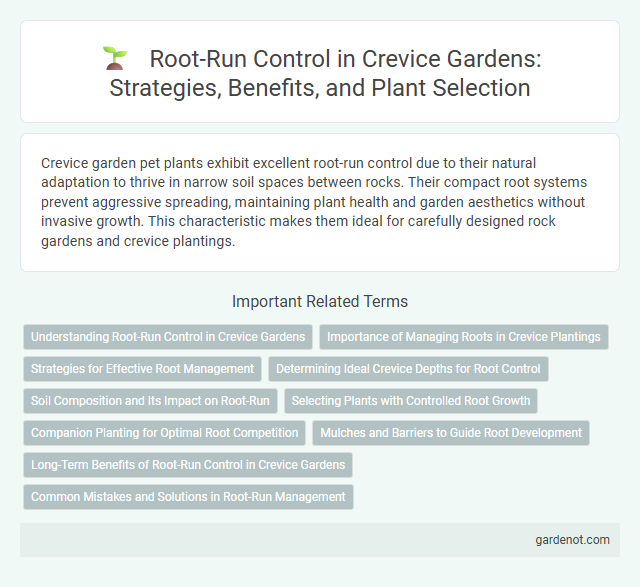Crevice garden pet plants exhibit excellent root-run control due to their natural adaptation to thrive in narrow soil spaces between rocks. Their compact root systems prevent aggressive spreading, maintaining plant health and garden aesthetics without invasive growth. This characteristic makes them ideal for carefully designed rock gardens and crevice plantings.
Understanding Root-Run Control in Crevice Gardens
Root-run control in crevice gardens is achieved by carefully selecting stone materials and spacing to restrict root expansion and ensure adequate drainage. Understanding the root behavior of alpine plants allows for precise manipulation of soil depth and crevice width, promoting healthy growth and preventing root rot. Effective root-run control supports optimal plant stability and mimics natural rock crevice ecosystems for sustainable garden management.
Importance of Managing Roots in Crevice Plantings
Managing root growth in crevice gardens is crucial to prevent overcrowding and ensure optimal nutrient uptake for each plant. Effective root-run control maintains soil aeration and water distribution, supporting healthy plant development in the narrow, rocky spaces. Proper root management also reduces competition among species, promoting diverse and balanced crevice garden ecosystems.
Strategies for Effective Root Management
Implementing root-run control in a crevice garden involves selecting plants with compatible root systems to prevent overcrowding and nutrient competition. Using physical barriers such as stone partitions or root pruning techniques helps maintain healthy root boundaries and enhances water absorption efficiency. Regular monitoring and strategic soil amendments support optimal root growth, ensuring plant stability and overall garden vitality.
Determining Ideal Crevice Depths for Root Control
Determining ideal crevice depths for root control in crevice gardens involves balancing soil volume and aeration to restrict excessive root growth while ensuring plant health. Optimal depth typically ranges between 12 to 18 inches, allowing roots to anchor securely without promoting invasive spreading. Precise root-run control enhances plant stability and minimizes competition, crucial for maintaining the distinct vertical structure and varied flora characteristic of crevice gardens.
Soil Composition and Its Impact on Root-Run
Soil composition in a crevice garden critically influences root-run control by dictating water retention, aeration, and nutrient availability. A well-draining mix of sand, gravel, and organic matter limits excessive root spread while promoting healthy plant growth. Properly balanced soil reduces root crowding and competition, ensuring optimal plant health and sustainable root development.
Selecting Plants with Controlled Root Growth
Selecting plants with controlled root growth is essential for effective root-run control in crevice gardens. Species such as sedums, sempervivums, and low-growing alpine plants naturally restrict root expansion, preventing overcrowding and ensuring optimal nutrient absorption. Proper plant selection enhances stability within rock crevices and promotes sustainable growth in limited soil environments.
Companion Planting for Optimal Root Competition
Companion planting in crevice gardens strategically combines plants with complementary root structures to optimize root-run control and minimize competition. Selecting species with varying root depths and growth rates enhances nutrient uptake efficiency and prevents aggressive root dominance. This method promotes healthier plant development and sustains soil structure within the confined crevice environment.
Mulches and Barriers to Guide Root Development
Mulches and barriers play a crucial role in root-run control within crevice gardens by directing root growth and preventing unwanted root spread. Organic mulches like bark or compost improve soil moisture retention and slowly decompose, enriching the substrate while limiting root penetration into undesired areas. Physical barriers made from materials such as plastic sheets or metal strips effectively guide roots toward crevices, ensuring focused development and maintaining the garden's structural integrity.
Long-Term Benefits of Root-Run Control in Crevice Gardens
Root-run control in crevice gardens enhances soil stability by directing root growth through narrow fissures, improving plant anchorage and nutrient uptake over time. This controlled root expansion reduces soil erosion and water loss, promoting sustainable moisture retention in rocky environments. Long-term benefits include increased plant resilience and reduced maintenance needs, supporting ecologically balanced crevice garden ecosystems.
Common Mistakes and Solutions in Root-Run Management
Common mistakes in root-run control for crevice gardens include overwatering, which leads to root rot, and poor soil aeration that restricts healthy root growth. Implementing well-draining substrates like gritty sand or coarse gravel and monitoring moisture levels can prevent root damage and promote robust root systems. Using root barriers or compartmentalizing roots also limits invasive root spread, ensuring balanced plant development.
Root-run control Infographic

 gardenot.com
gardenot.com